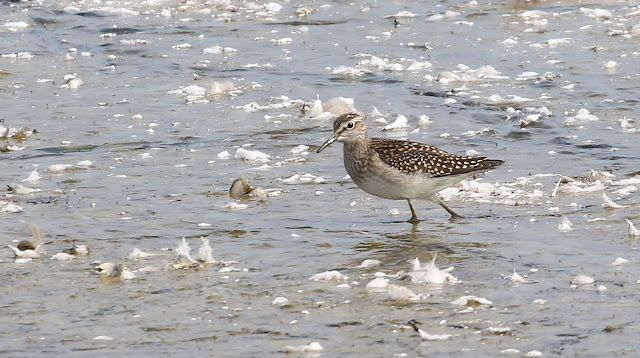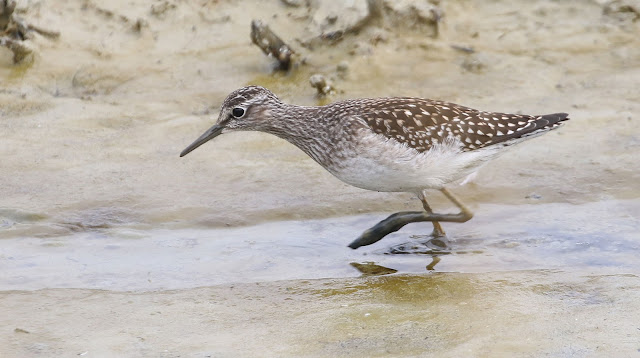News broke the evening before of a White-winged Tern seen off the beach at Hill Head and Salterns. I arrived just after sunrise at the sea wall, around 6:30 and the tide was still out but rising, the sea was still and calm, but with no sign of any terns either on the beach or feeding off shore.
A walk down to the sailing club and a scan of the sea produced a single Black Tern feeding in amongst the tern and gull flock immediately off shore, but we could also a large feeding flock away to the east, off what was likely to be Salterns car park.
Walking back to check the rainbow bar two Water Rail could be seen feeding along the edge of Duck Lake, they made their way along the edge of the mud, waving in and out of the stubble reeds. It was still quite dull and the birds were distant so these are only record shots.
Terns were starting to arrive on the Rainbow Bar and there was also a good number of Mediterranean Gulls too. Ringed Plover could be seen amongst the Turnstone and the maximum count was of 31.
A flock of around 30 Yellow Wagtail flew from the west side of the reserve over our heads on the sea wall.
The sun had been up for about 30 minutes but was now starting to break through the low cloud, across the sea the Island was obscured by the mist that was hanging over the water.
The mist helping to enhance the golden light or the morning along the coast.
And also the sunlight reflecting in the sea took on a golden hue.
The stillness of the water and the monochromatic conditions around the reed bed led to a lovely composition of a Grey Heron, I decided that black and white would be the best way to capture this.
Closer in a Black-tailed Godwit stretched as it preened, throwing a lovely reflection in the still water.
Back on the sea the tide was rising quickly now and this was pushing the waders feeding on the beach under Brownwich Cliffs along the shore and past us. A sizeable flock of Oystercatchers came initially low over the water, but rose a little higher into the air as they passed us. Once again I went for Black and white to turn a rather mundane shot into something special.
Despite the easterly wind and misty conditions there was very little moving on the sea. The feeding tern and gull flock was away to the east and too far away to make out positive identifications. As a result we decided to go for a walk, at first around the chalets and then up the Canal Path. In hindsight this was to be a mistake.
As we walked along the beach, the Mediterranean Gulls were flushed along with the Terns and waders by dog walkers from the Rainbow Bar.
There was very little around the chalets, just a few Chiffchaffs and a Whitethroat. Stepping on to the Canal Path there was another Whitethroat in a Hawthorn bush and then appearing at the top a Lesser Whitethroat.
We walked a little way along the canal path with just the odd call from a Chiffchaff, then a message came in to say that four Balearic Shearwaters had passed close in going east, if we had stayed they would have been close, but we didn't. However we decided to return as maybe things were moving now on the sea.
As we made our way back to the sea wall Ian picked up a Whinchat in the bushes around the west side entrance to the reserve. It showed briefly and as this was the reason for walking the Canal Path we were quite pleased to find this one here.
There have been good numbers coming through the country over the last week so it was nice to catch up with one here and not have to put in the miles to find one.
Back at the sea wall there was little interesting movement, only fly pasts and overheads from Common Terns
And a few Sandwich Terns
The one surprise though was a single Brent Goose that flew est to east and along the shore, my earliest of the second winter ever.
With the bar now almost covered the Ringed Plover were heading for the beach behind the harbour.
It was time to check into the reserve and we walked back around to the visitor centre. With the sun and the high tide the harbour entrance was silhouetted.
As were the Turnstone starting to gather on the harbour wall, again best viewed in Black and White.
The ducks gathering around the bridge in the hope of food as the visitor centre opened drifted in and out of the reflections cast by the masts of the sailing boats in the harbour, yet another subject for the black and white media.
Outside the visitor centre we came across a very settled Migrant Hawker dragonfly.
Checked in we headed for the Meon Shore Hide on the west side of the reserve. The hide was empty and in front of us was the Wood Sandpiper, one of two that had been present through the week.
We had hoped that there would be a chance that it would be close today and we were not disappointed, the low water levels being far to attractive, so at last some good photographs of this rather dainty wader.
Over the last few weeks there have been several about and this was my second from the Meon Shore Hide, but previously the bird stayed distant on the left hand side and I was having to digiscope. Here it was feeding in the company of a Redshank, more of which later.
Then it called with the distinctive whistle and flew off away to the left
With the Wood Sandpiper gone I became interested in the wader now in front of the hide. I couldn't see the legs as they were covered in mud, and the plumage was much more scaly. However a bit closer inspection could just make out a pale red / orange colour beneath the legs and we then realised that we were looking at a juvenile Redshank.
Away from the Redshank and the Wood Sandpiper there were Green and Common Sandpiper, Snipe and Black-tailed Godwits.
The Snipe in still reflective water
And the Black-tailed Godwit with a muddy beak
Another Snipe, a little closer
A juvenile Little-ringed Plover, one of three present.
One of three Common Sandpipers
But the Wood Sandpiper was the star of the show and was continuing to show very well just to the left of the hide amongst the shed feathers.
We decided to move on to the Pumfrett Hide. On the north scrape the water level was really low and there were two Ruff present to add to the wader count and another Wood Sandpiper.
A pair of Greenshank had been calling continuously and we caught up with one from the hide at the north end of the South Scrape.
Both then flew towards the Meon Shore Hide where we could see them in front of the hide. We decided to head back to the Meon hide and try to catch them there.
On entering the hide there was no sign of the Greenshank, who had returned to the north end, but the Little Ringed Plover was much closer now in front of the hide.
A Rock Pipit could be seen foraging amongst the mud and stubble at the base of the hide.
The Wood Sandpiper was still around and started to make its way from left to right coming ever closer to the hide, crossing the small island in front and providing a different background.
A pause to stretch and preen
Then across the mud once again coming ever closer.
I provided background on this wader in my previous post from here at Titchfield back in July, details can be found
here
I love the winding trail through the mud.
Then literally in front of the hide where the teasels would make it difficult to get a clear view it was that close.
Finally as we were about to leave it stood close to the island to the left, with the vegetation to help frame the scene.
So that was the morning, it was time for lunch and then moving on for an afternoon of butterflies we hoped








































































No comments:
Post a Comment